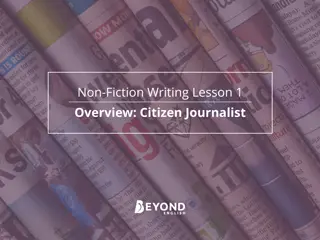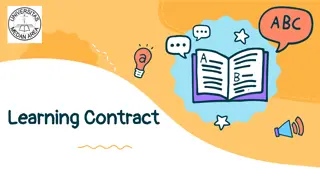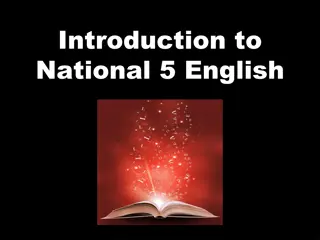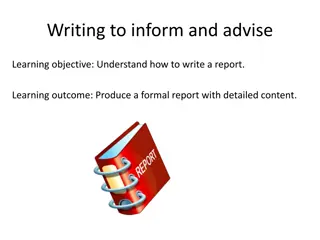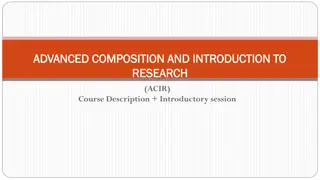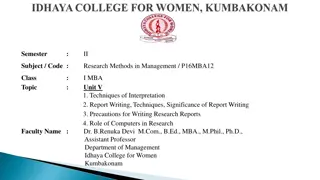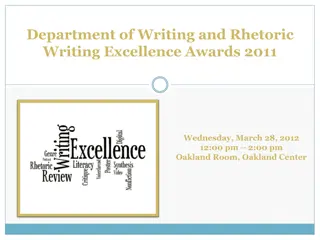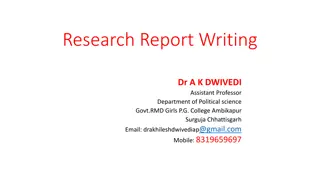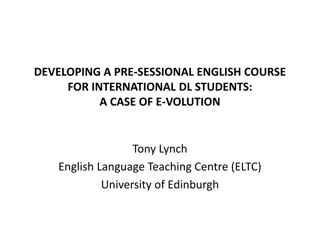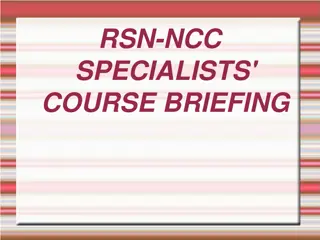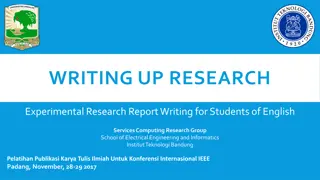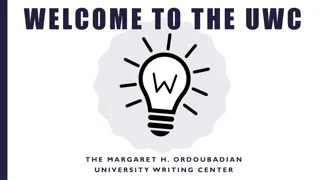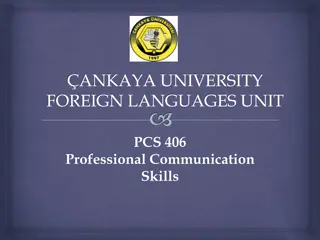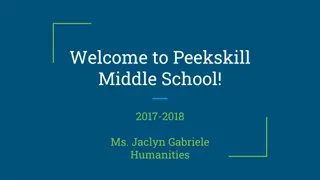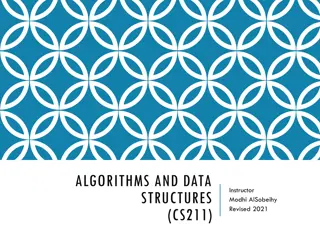Ankaya University RTW405 Report Writing Course Details
"Learn about the RTW405 Report Writing course at Ankaya University's Foreign Languages Unit. The course is designed to enhance students' report writing skills for academic and professional purposes. Details include the course description, attendance requirements, grading breakdown, and term project portfolio assessment. Don't miss out on essential information such as instructor details, course length, and where to buy the required book."
Download Presentation

Please find below an Image/Link to download the presentation.
The content on the website is provided AS IS for your information and personal use only. It may not be sold, licensed, or shared on other websites without obtaining consent from the author.If you encounter any issues during the download, it is possible that the publisher has removed the file from their server.
You are allowed to download the files provided on this website for personal or commercial use, subject to the condition that they are used lawfully. All files are the property of their respective owners.
The content on the website is provided AS IS for your information and personal use only. It may not be sold, licensed, or shared on other websites without obtaining consent from the author.
E N D
Presentation Transcript
ANKAYA UNIVERSITY Foreign Languages Unit RTW405- Report Writing
Basics about the Instructor Name & Surname: Office: Office Number: E-mail address:
Course Description RTW 405 is a report writing course designed to help students acquire necessary skills of writing a report required for academic studies and professional purposes. LENGTH & PERIOD: 2 hours per week; 14 weeks and 28 hours in total
COURSE PACK You have to bring your book to follow the course. Where can you buy the book? The copy center
ATTENDANCE Students are required to attend classes and examinations. Minimum required attendance is 80% for class sessions per semester, which makes up 6 hours of absence at most. Students who miss an exam will not be given a make- up exam unless they submit an approved medical report or any other official document proving their excuse.
ATTENDANCE Students can bring documents for the classes if they have problems such as Illness (copy of doctor s report within 15 days) Clash (copy of student s program) Excuses related to ankaya (document from the university) Working (any document) All documents about absence will be given to the instructor
GRADING MIDTERM: 20% FINAL: 25% TERM PROJECT (portfolio): 40 % OVERALL IN-CLASS PERFORMANCE: 10 % TEACHER ASSESSMENT: 5 %
TERM PROJECT PORTFOLIO : Portfolio Assessment (40%) The portfolio tasks and their points are listed below: Task 1 : Making Situational Analysis (5 pts) Task 2 : Making the outline (5 pts) Task 3: Writing the Introduction part of the report (10 pts) Task 4: Writing the Body part of the report (10 pts) Task 5: Final draft of the report (10 pts)
TERM PROJECT Portfolio Assessment Policy You will write at least 2 drafts for your portfolio tasks. Then, their individual scores will be added together and the total score will be obtained. This total score will be divided by 2 in order to have your score for that particular portfolio task.
TERM PROJECT Portfolio Assessment Policy You have to write the first draft of the portfolio tasks in the classroom and you must submit it to the course instructor at the end of the lesson. If you don t submit it, you will lose half of the points assigned to that task and you have to write it in the next writing lesson.
TERM PROJECT Portfolio Assessment Policy If you fail to be in the classroom on the portfolio day without an official written excuse(e.g. a health report), you will lose the half of the points assigned to the task and you have to write your first draft in the next writing lesson. If you fail to be in the class without an official written excuse again in the next writing lesson, your score for that task will be 0.
TERM PROJECT Portfolio Assessment Policy Late Submissions Policy If you fail to submit the final draft of the portfolio task on the due date, you will be able to submit it in The Late Submission Period in return for the half of the points assigned to that task. The Late Submission Period ends in 7 days starting from the due date. If you fail to submit your task within The Late Submission Period , your score for that assignment will be 0.
TERM PROJECT Turnitin You need to upload your 4th task to Turnitin. So, create an account as soon as posible.
Now answer these questions What is the website of the course? What is the limit of absenteeism in this course? What happens when you exceed the limit of absenteeism? In case of missing an exam, how can you take a make-up exam? What is the percentage of porfolio? What happens if you don t write the 1st drafts in the classroom? How long does late submission period take? What is the expectation of the instructor from you throughout the course? How can you contribute to the course during the lesson?
Lets start with the course! Fundamentals of Technical Writing
Technical vs. Non-technical Writing
What do you know about technical writing? Technical writing is different from non-technical writing such as fiction and essays. It is writing that deals with science and technology. Although technical writing is primarily used in engineering, it is involved in all areas of physical, natural, and social sciences.
Have you ever written technical reports thus far?
How is technical writing different from non-technical writing? Accuracy is more important than style. Its purpose is to transmit information.
How is a report similar to an essay? Formal style Introduction, body, & conclusion Analytical thinking Careful proof-reading & neat presentation
How is a report different from an essay? Presents information, not an argument Is meant to be scanned quickly by the reader Uses numbered headings and sub-headings Uses short, concise paragraphs and dot-points Uses graphics May need an abstract/executive summary Always needs references and bibliography Is often followed by recommendations and/or appendices
Reports vs. Essays A common problem in report writing is that students transfer what they have learned about essay writing to report writing. However, there are some essential differences between the two.
REPORT ESSAY Presents information Presents an argument/opinion Is meant to be scanned quickly by the reader Uses numbered headings and sub- headings Is meant to be read carefully Uses minimal sub-headings, if any. Always needs references and bibliography/reference list Uses short, concise paragraphs and dot-points where applicable May not need references and bibliography/reference list Links ideas into cohesive paragraphs, rather than breaking them down into a list of dot-points Rarely uses graphics Uses graphics wherever possible (tables, graphs, illustrations) May need an abstract (sometimes called an executive summary) Will only need an abstract if it is very long, or if your lecturer asks for one specifically Seldom has recommendations or appendices May be followed by recommendations and/or appendices
Task 1 Complete the table by putting characteristics into the correct column and row.
A report An essay Topic 1. 2. I M D F Purpose 3. 4. 5. B Reader 6. 7. G H Format 8. 9. L A K Style 10. 11. C Assessment 12. 13. E J
What are some types of reports? Recommendation report Feasibility report Informational report Progress report Trip report
Reports Reports are written for specific audiences and this results in certain characteristics in terms of style and format. The aim is to present information clearly. As a result, there are seperate sections with a heading and a numbering system. These sections are shown in the Table of Contents part. See the example on page 20.
Reports You need to repeat information in seperate sections of the report because reports are not usually read from cover-to-cover by one person. Different people focus on different parts of it. For instance, a manager may read the abstract. A technical officer may read only the section that explains how things work. A personnel officer may read the conclusions and recommendations part that directly affects his working area.
Basic Characteristics of Reports Technically accurate Useful Concise Complete Clear Consistent Correct in spelling, punctuation, grammar Targeted Well-organized
Guidelines for Effective Technical Writing 1. Write short sentences (of 12 to 25 words) 2. Use active voice 3. Use parallel structure 4. Avoid strings of choppy sentences 5. Aavaid redundant phrases 6. Use there are sparingly 7. Avoid run-on sentences 8. Avoid sentence fragments 9. Use headings to clarify parts See p. 22 for example headings
2. COMPARISONS BETWEEN iOS AND ANDROID In this part of my report, I will compare iOS and Android in many aspects like their operating system, history, features and market value. 2.1 Introducing the Operating System 2.1.1 iOS operating system It is a mobile operating system developed by Apple and distributed exclusively for Apple hardware. The operating system is based on the Macintosh OS X. It is the operating system that powers many of the company's iDevices such as the iPhone, iPad and iPod Touch. Designed for use with Apple s multi-touch devices, iOS supports input through direct manipulation. The system responds to various user gestures, such as pinching, tapping and swiping (Rouse, 2013, para. 2). 2.1.2 Android operating system Android is an operating system. It is created by Google Teams for use on device such as smartphone and tablet. It is an operating system that is available on devices made by various manufacturers, giving you more choices of device style and pricing. Also, the Android operating system allow you can customize your devices in many different ways (Google, 2014, para. 3).
As the Foreign Languages Unit, We We wish wish you a you a happy successful successful semester semester happy and and


